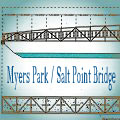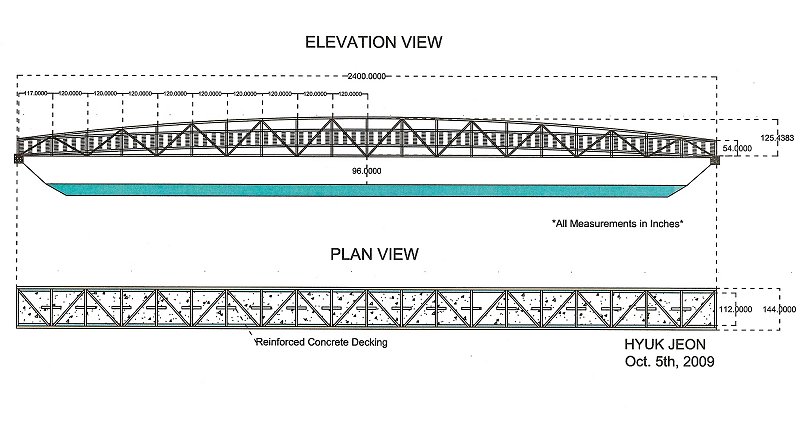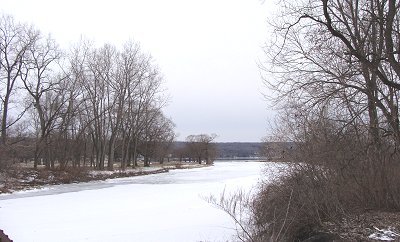- By Dan Veaner
- Around Town
 Print
Print  When the Town of Lansing began managing Salt Point in 2006 the idea was to create a sister to Myers Park. Myers would be the rambunctious sibling, with camping, parties, Harbor Festival, 4th of July Barbecue, Concerts in the Park, the playground, swimming, boating, and all manner of activities. Salt Point would be the quiet sister, a park where you could go to meditate, watch indigenous birds, launch a non-powered boat, or watch the sun set. From the beginning a part of the plan was a walking bridge to connect the two parks. Because there is no intention to use tax money to build it, the bridge is a dream unless other money appears. If it does the design and plans will be ready because of a project taken on by Cornell civil engineering students.
When the Town of Lansing began managing Salt Point in 2006 the idea was to create a sister to Myers Park. Myers would be the rambunctious sibling, with camping, parties, Harbor Festival, 4th of July Barbecue, Concerts in the Park, the playground, swimming, boating, and all manner of activities. Salt Point would be the quiet sister, a park where you could go to meditate, watch indigenous birds, launch a non-powered boat, or watch the sun set. From the beginning a part of the plan was a walking bridge to connect the two parks. Because there is no intention to use tax money to build it, the bridge is a dream unless other money appears. If it does the design and plans will be ready because of a project taken on by Cornell civil engineering students."We wanted to get from point A to point B," Colt says, explaining the parameters of a contest held last Fall. "We wanted it to fit the setting. We wanted it to be safe, top-notch construction and design. And we wanted it so it didn't rely on being supported by anything within the water itself. We wanted a clean span all the way across, and with enough elevation so that high water in the Spring, trees, ice would flow down and go underneath it."
The contest was phase one of a three-phased project taken on by the Cornell student chapter of the American Society of Civil Engineers (ASCE). Students measured the 164 foot span across Salmon Creek, and were charged with coming up with a sketch design for a pedestrian bridge. Phase two is underway now, in which students will collaborate to do a structural analysis, research materials, member sizing, and costs. The third phase will be to produce working drawings from which the bridge can be built.
"We want to get it to be completely buildable," says Cornell ASCE Community Service Chair Nicole Dufalla. "We want to be able to present Lansing with some kind of design plan that they can just take and actually build it when the time is right. Just to be able to give them a design they can build from whenever they can is our goal."
 bridgeDesign800.jpg
bridgeDesign800.jpgThree entries were submitted for the design phase, with the winning entry by Hyuk Jeon. The bridge is 200 feet from end to end with a railing and a graceful curve.
"All of them were nice renderings, but one stood out above the others," Colt says. "I think what you'll have will be abutments on either side that will be raised and probably made of concrete. We'll have ramps that go back and forth to get up to the bridge deck. It's easy to get up, it's handicapped accessible, and if we had to take a piece of power equipment across it we could."
Raising the bridge has a practical purpose. When surface ice is pushed up by increasing water underneath in the Spring, it tends to push the ice to the sides. This can damage park and private land, and even divert water into the camping area in Myers Park. Colt says this was an imminent danger last year until the ice suddenly broke and pushed into Cayuga Lake, relieving the pressure.

Currently the Town is waiting for a grant application to be approved by the DEC that will allow the Town to remove silt and gravel that has accumulated on either side of the creek, narrowing the channel and exacerbating the problem. Lansing Town Engineering and Planning Coordinator Jeff Overstrom says that weather permitting, the gravel will be removed in early Spring. DEC only permits the Town to remove material at and above the water line so as not to disturb natural wildlife indigenous to the area.
"They will dictate when we can do this, because of the trout spawn," Overstrom says. "We want to get in there when the water is at its lowest. The rains in December really put a hold on things. Hopefully we'll be able to get in there and scratch off the gravel before April 1st."
Dufalla says the Cornell ASCE chapter looks for community service projects to become involved in the community as well as to expand educational opportunities. Projects may be as modest as participating in an 'Adopt A Highway' cleanup project. But the projects that really capture the students' imaginations are engineering projects that are often actually built.
This group is no stranger to designing local community bridges. Members designed a suspension bridge at Fall Creek that is part of the Cayuga Trail in 1982. Two pedestrian Bridges were designed for the Connecticut Hill Wildlife Preserve about ten years ago. A recycled plastic bridge on Route 79 was also designed by chapter members.
It's been four years since the Town signed a 25 year renewable lease with the New York Department of Environmental Conservation (DEC) to manage Salt Point. Since then the point has been cleaned up considerably, but a lot of the plan for the natural area has been more dream than reality. Little by little improvements have been made. In January Park Superintendent Steve Colt announced that the DEC had placed another order for trees and shrubbery for the point at no cost to the Town.
But pieces of the plan like informational kiosks and the walking bridge depend on money being found that does not come from tax dollars. Over the past few years Colt has been working on a number of grants with some success. The money has benefited the Concert In The Park series, and will place a Liberty Tree in Myers Park this Spring. He says there are grants available for municipal projects like the bridge, and it is a matter of finding them and applying.
"The downside to making it a reality is the bottom line. I don't think one single taxpayer dollar is ever going to be driven in that direction, and probably rightfully so," he says. "A grant or fundraising, or a gift are probably the only ways you will ever see a bridge down there. It would be very nice. It would be unique. It would be a draw. People would come to see it. I think it would make both sides very functional."
Last April Lansing Community Council Ed LaVigne said that he would like the council to take on fundraising for the bridge, though no formal plans have been set at this stage. Following on the heels of a successful fundraising effort to reassemble Lansing's historic 1791 log cabin last summer, the Community Council is now trying to raise about $130,000 to replace the playground in Myers Park. Colt says fundraising for the bridge has not been discussed seriously yet. But he notes that if the Community Council could pull it off it would be a testament to the community and the council's ability to rally it.
"It would be the trifecta of unbelievably challenging fundraising feats, that's for sure!" Colt says. "Number one was the log cabin, number two is the playground, and number three the bridge. Those are mighty lofty goals for anybody to fundraise for individually, much less the triple play."
Dufalla says the details of the second phase of the design project are being worked out now. She says it is likely that the students will work as a group to work out the engineering of the design. She also says that she hopes chapter members can be involved when and if the money is raised to actually construct it.
"I think it's going to be a really great opportunity to get people involved and participating in a community event," she says. "I do like the idea of community collaboration, and I think it acts as a really important supplement to our education. Students are not only able to see the progress of an idea to a design to an eventual structure, but they can also make a lasting community contribution. I think that's important for students to see."
----
v6i6



